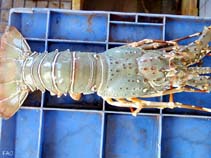Panulirus polyphagus (Herbst, 1793)
Mud spiny lobster| Native range | All suitable habitat | Point map | Year 2050 |

|
| This map was computer-generated and has not yet been reviewed. |
| Panulirus polyphagus AquaMaps Data sources: GBIF OBIS |
Classification / Names Common names | Synonyms | CoL | ITIS | WoRMS
Malacostraca | Decapoda | Palinuridae
Environment: milieu / climate zone / depth range / distribution range Ecology
Benthic; brackish; depth range 3 - 90 m (Ref. 4). Tropical; 26°N - 14°S, 64°E - 145°E (Ref. 107402)
Distribution Countries | FAO areas | Ecosystems | Occurrences | Introductions
Indo-West Pacific: from the coasts of Pakistan and India to Vietnam, the Philippines, Indonesia, Northwest Australia and the Gulf of Papua.
Length at first maturity / Size / Weight / Age
Maturity: Lm 10.5 range ? - ? cm Max length : 40.0 cm TL male/unsexed; (Ref. 4); common length : 25.0 cm TL male/unsexed; (Ref. 4)
It has lengths of 40 cm, maximum total body length; 20 to 25 cm, common length. Occurs at a depth range from 3 to 90 m, but usually less than 40 m (Ref. 4). Subtidal (Ref. 106854). It is found on muddy substrates and sometimes on rocky bottoms near river mouths in turbid water (Ref. 4). Lives mainly at river-influenced shelf in shallow, turbid water with moderate run-off (Ref. 105109). In general, palinurids are mainly considered carnivores, usually feeding upon sluggish, easily captured animals where most material is eaten alive or freshly killed (Ref. 105260). Individuals reared in captivity fed on a natural diet of gastropods, clams, crabs, squids and fish (Ref. 105110).
Life cycle and mating behavior Maturity | Reproduction | Spawning | Eggs | Fecundity | Larvae
Mating behavior: Precopulatory courtship ritual is common (through olfactory and tactile cues); usually indirect sperm transfer (Ref. 833).
Main reference
References | Coordinator | Collaborators
Holthuis, L.B. 1991. (Ref. 4)
IUCN Red List Status (Ref. 130435)
Least Concern (LC) ; Date assessed: 03 December 2009
CITES status (Ref. 108899)
Not Evaluated
CMS (Ref. 116361)
Not Evaluated
Threat to humans
Human uses
Fisheries: commercial
FAO - Aquaculture: production; | FishSource | Sea Around Us
Tools
More information
Internet sources
BHL | BOLD Systems | CISTI | DiscoverLife | FAO(; publication : search) | Fishipedia | GenBank (genome, nucleotide) | GloBI | Gomexsi | Google Books | Google Scholar | Google | PubMed | Tree of Life | Wikipedia (Go, Search) | Zoological Record
Estimates based on models
Preferred temperature
(Ref. 115969): 27 - 29.1, mean 28.3 (based on 1460 cells).
Resilience
(Ref. 69278):
High, minimum population doubling time less than 15 months (K=1.58-1.83; tm=2.2).
Nutrients: Calcium = 109 [35, 184] mg/100g; Iron = 1.59 [1.21, 1.97] mg/100g; Protein = 20.2 [19.2, 21.3] %; Omega3 = 0.285 [0.185, 0.386] g/100g; Selenium = 48.3 [-31.7, 128.3] μg/100g; VitaminA = 0 μg/100g; Zinc = 1.79 [1.17, 2.40] mg/100g (wet weight).



